
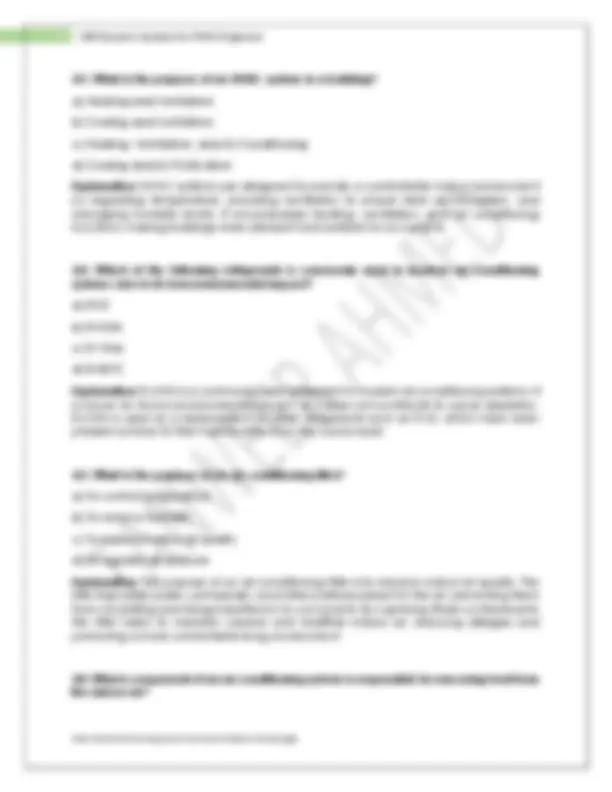
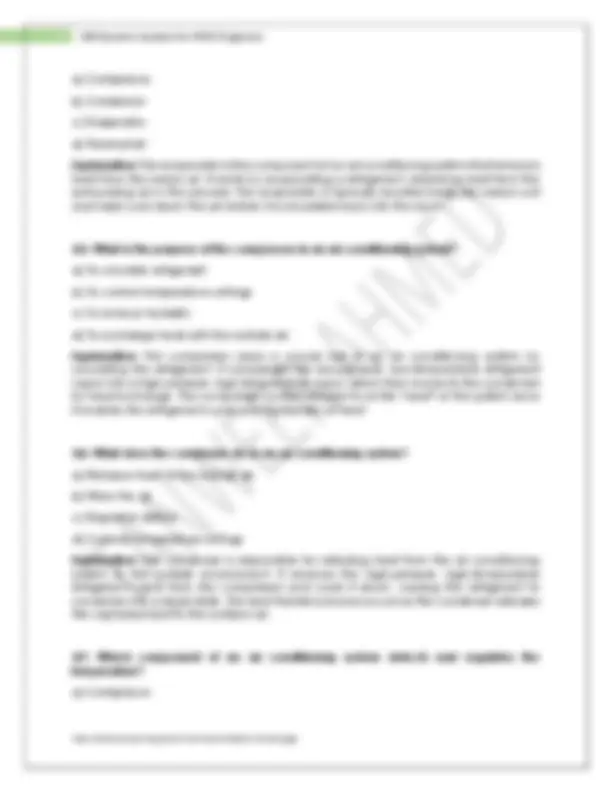
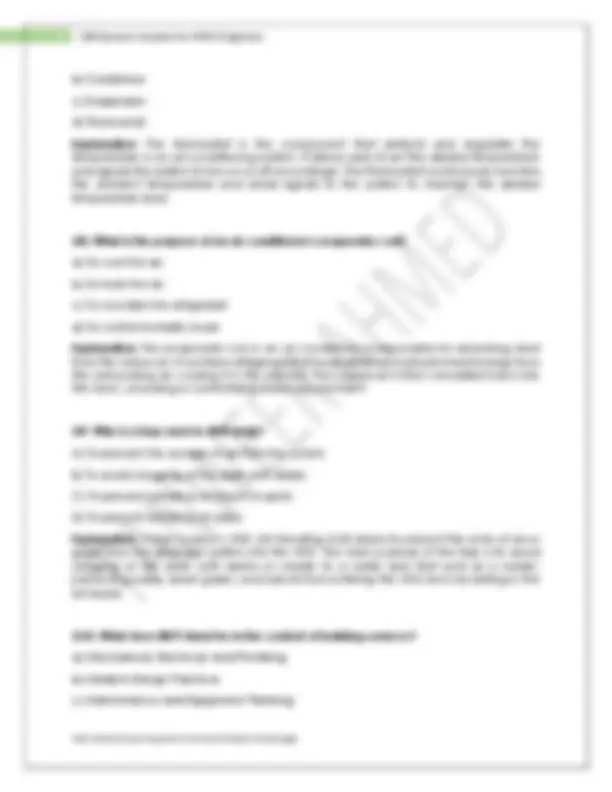
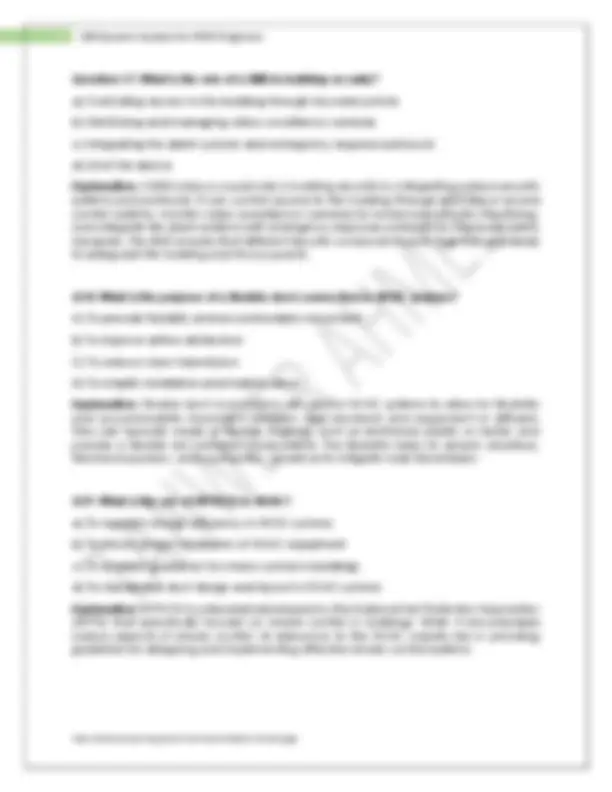
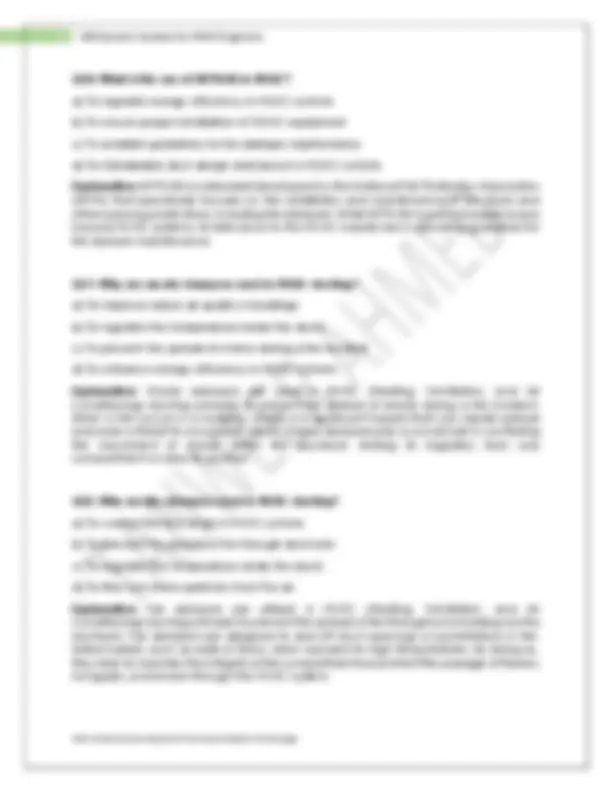
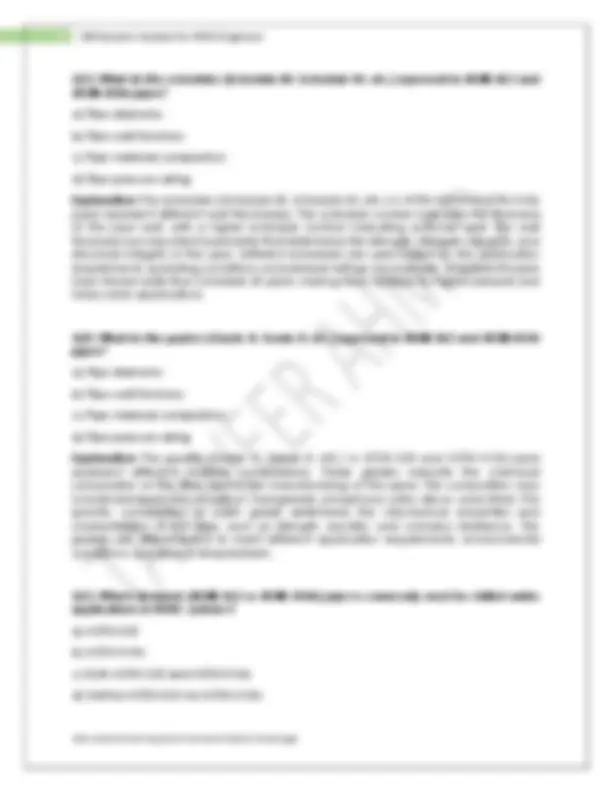
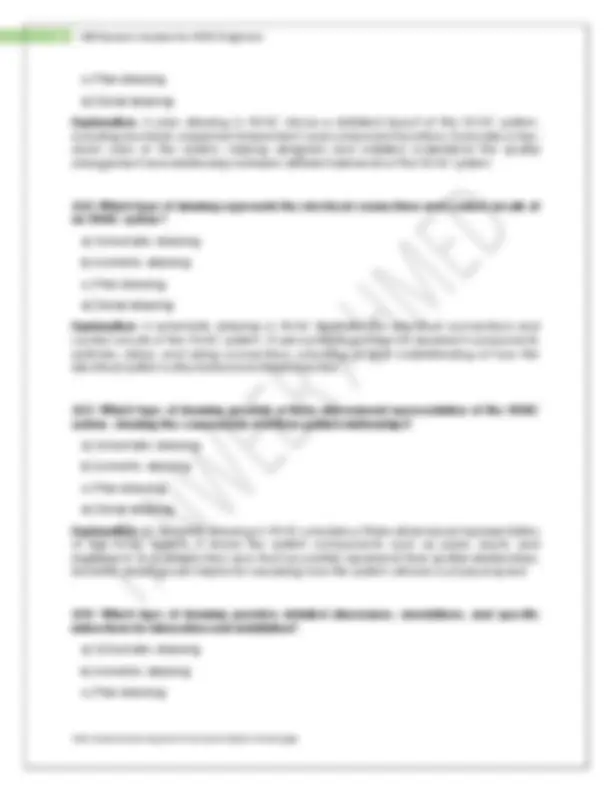
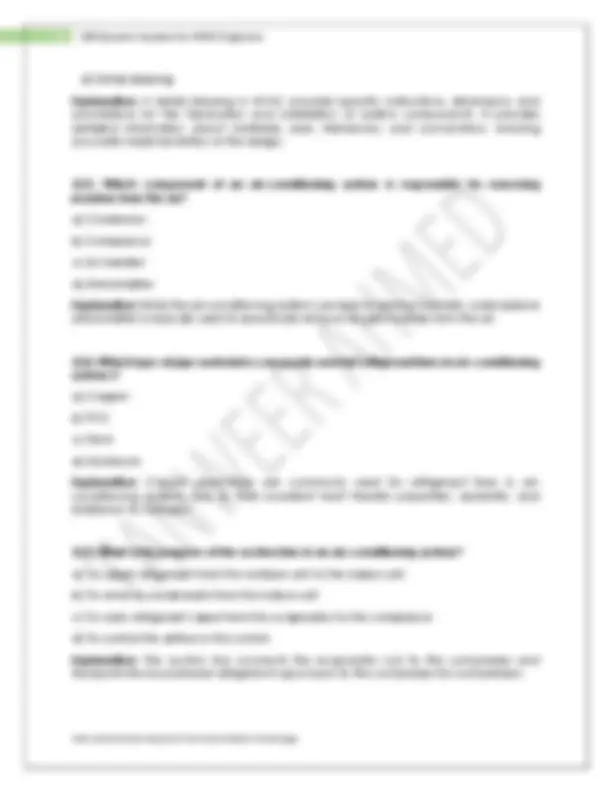

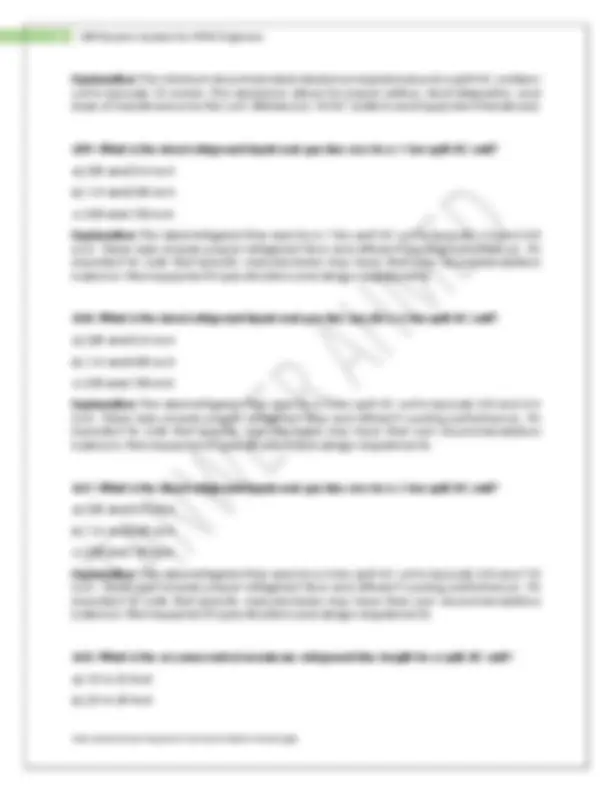
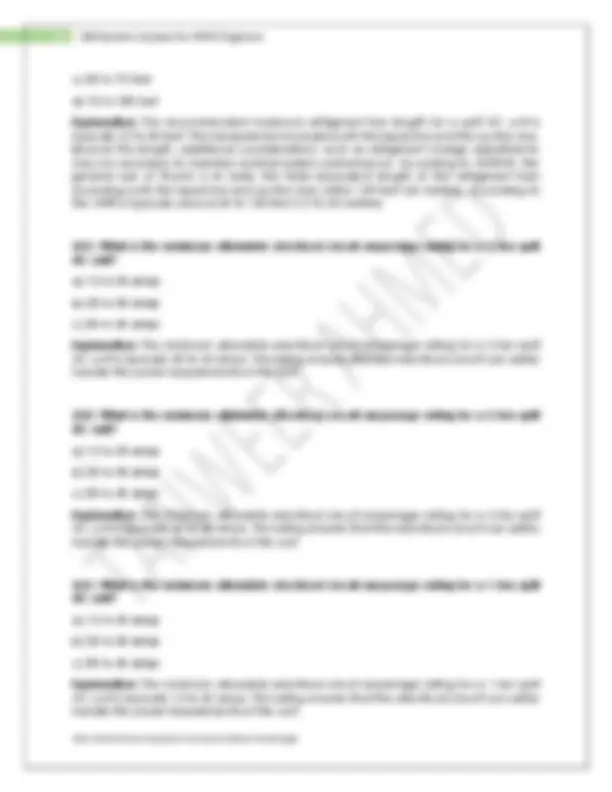
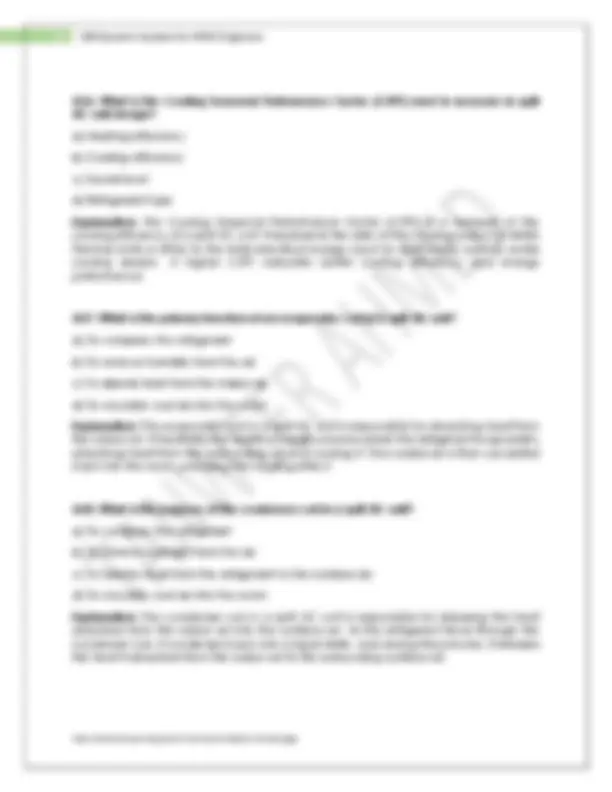
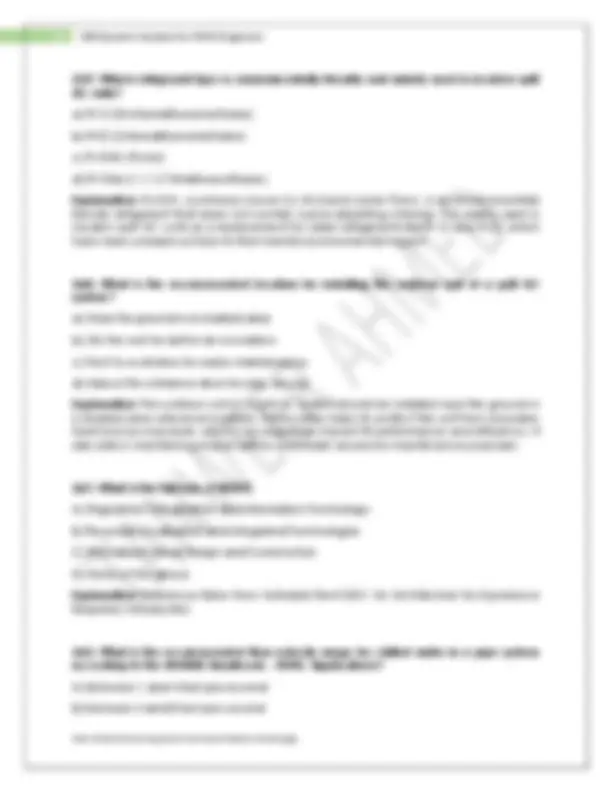
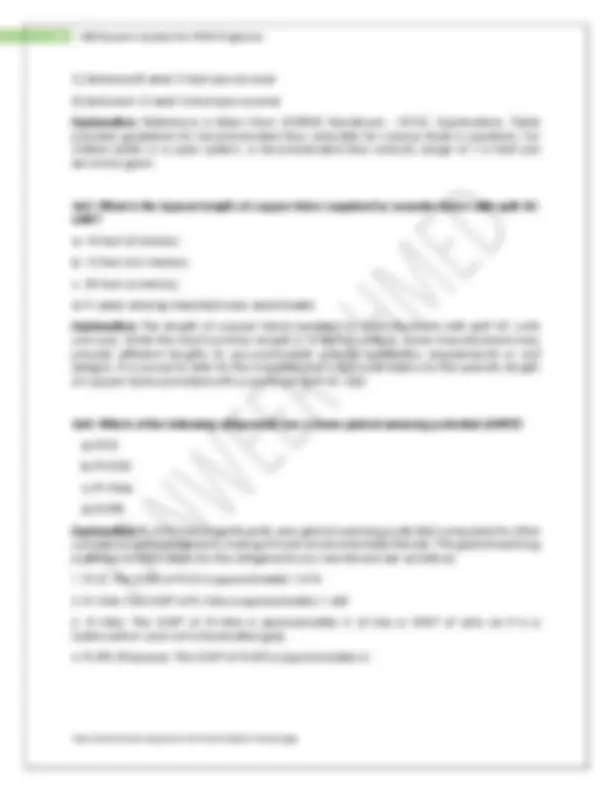
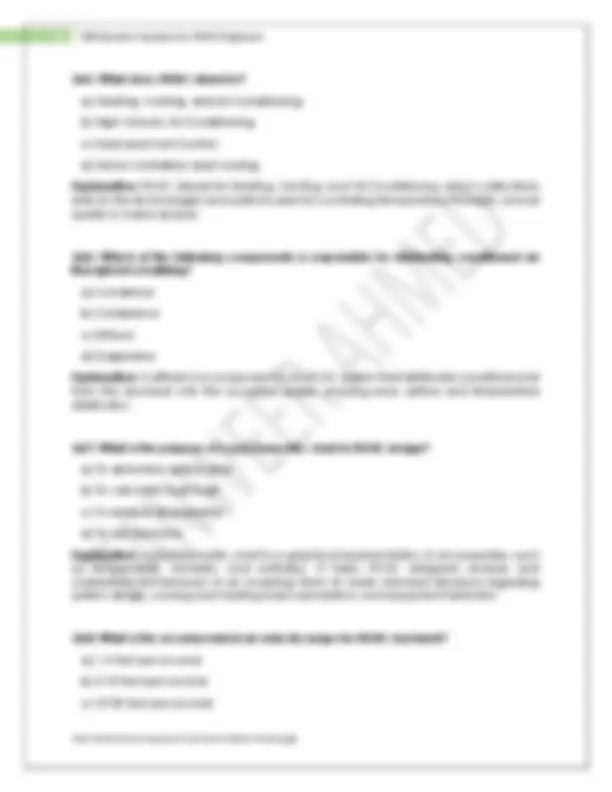
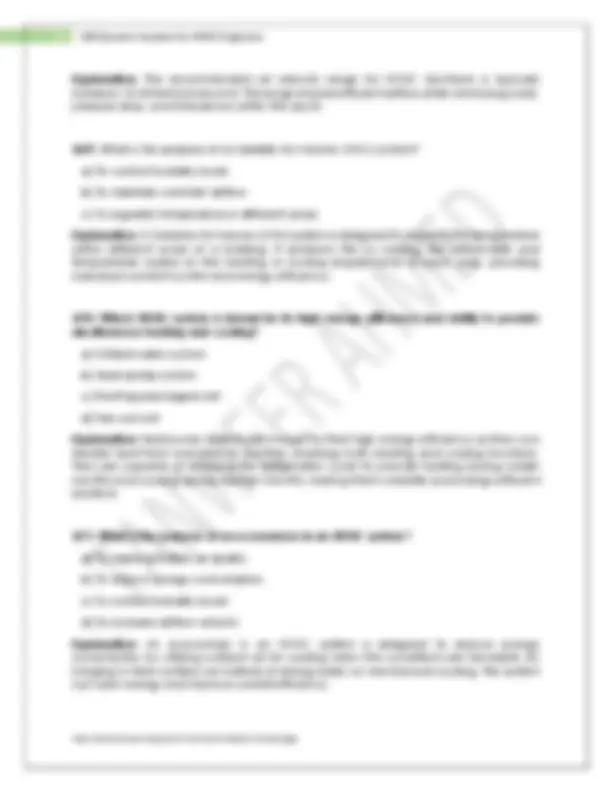
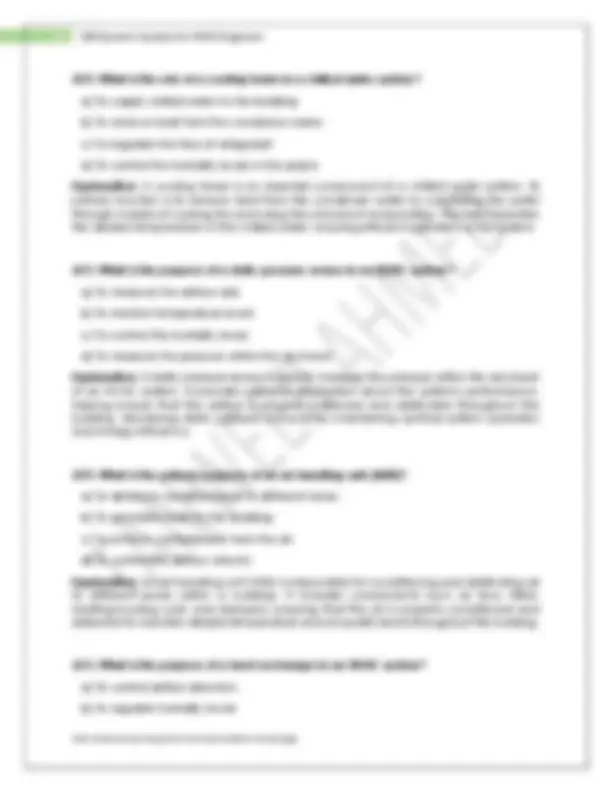
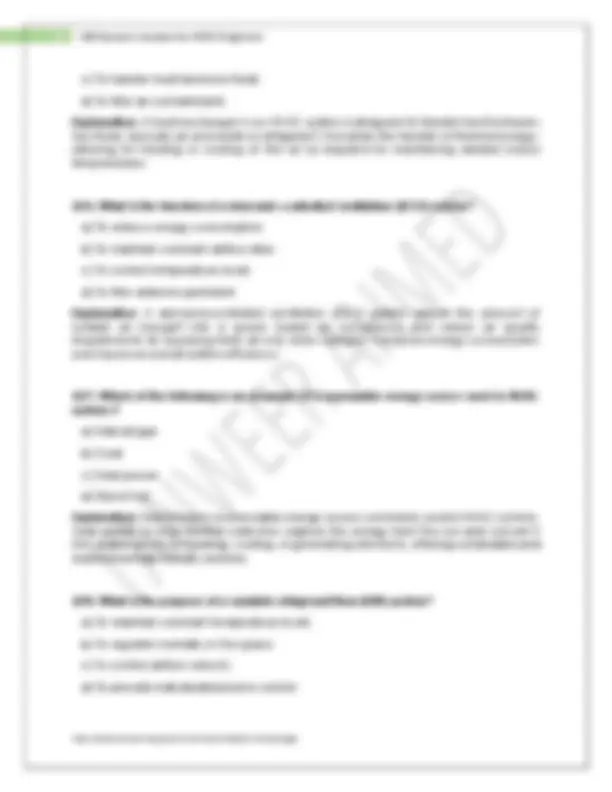
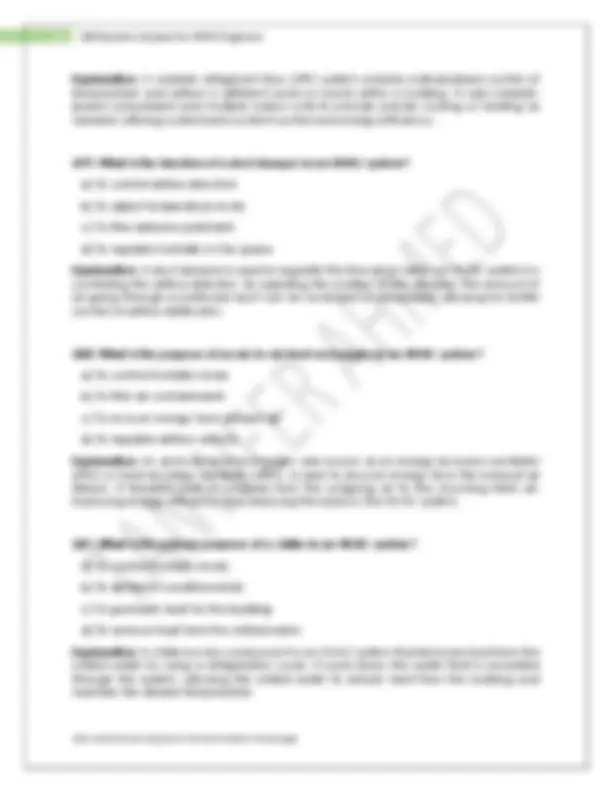
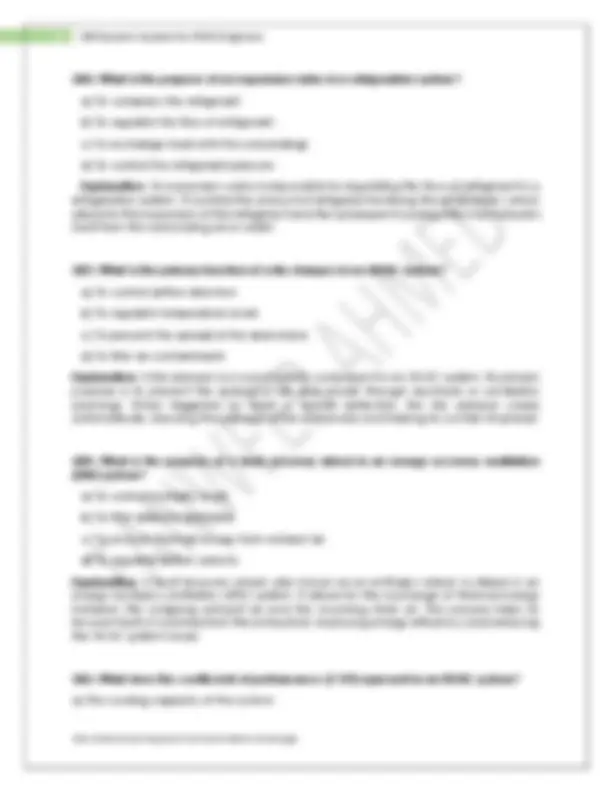
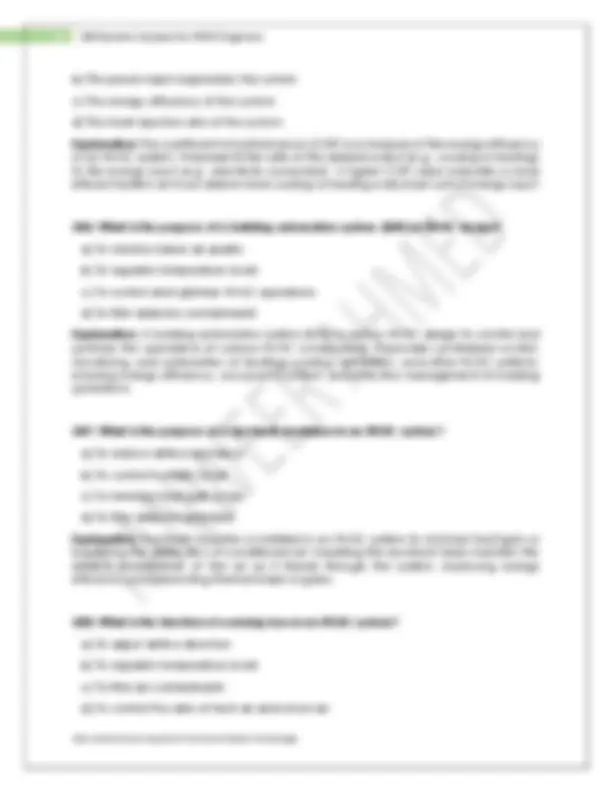
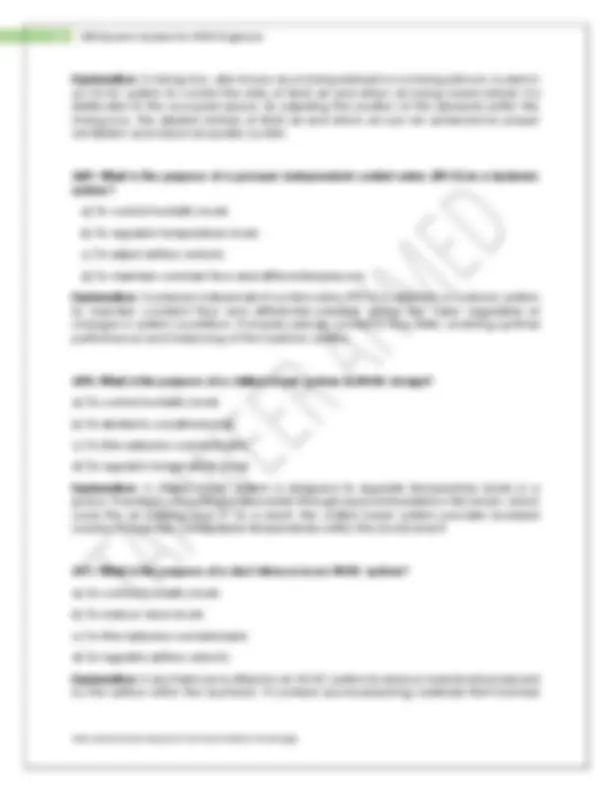
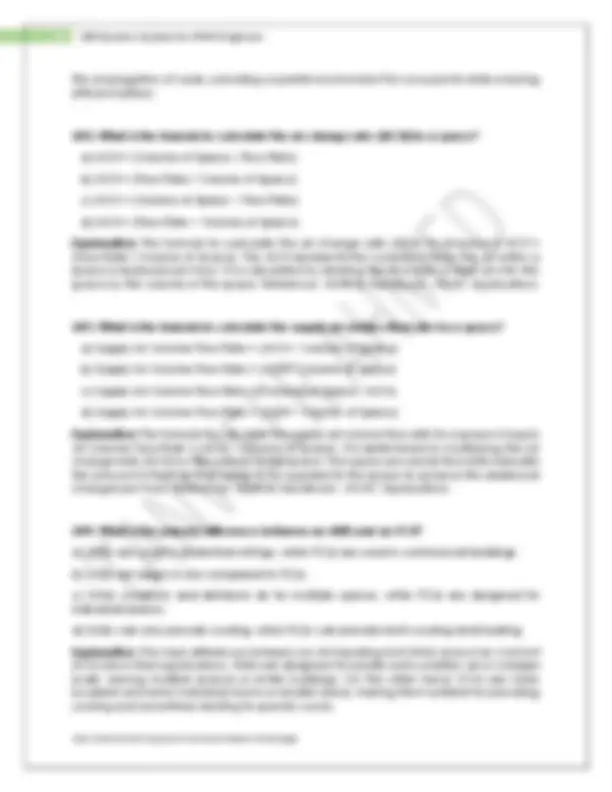
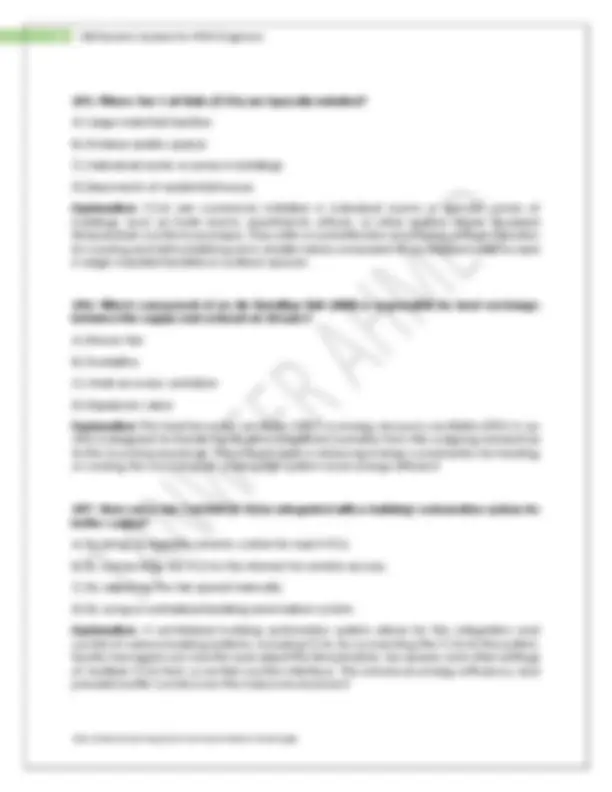
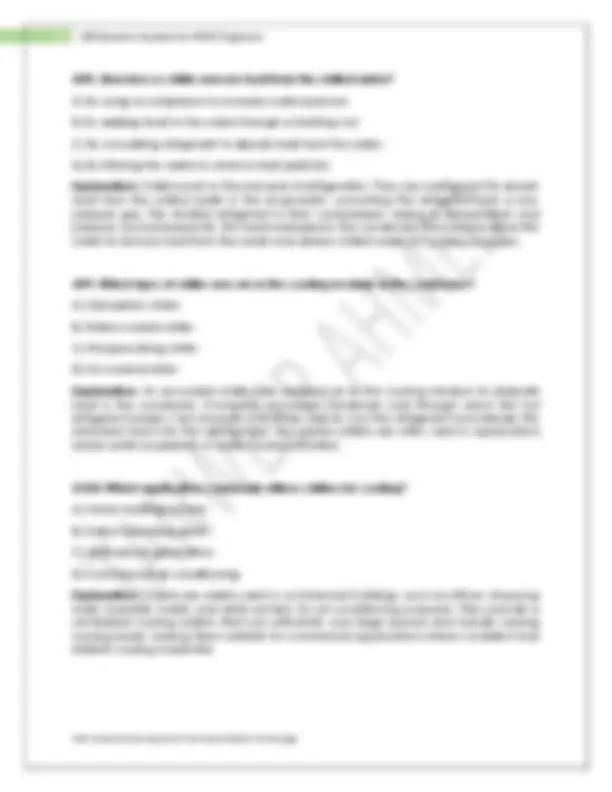




Study with the several resources on Docsity

Earn points by helping other students or get them with a premium plan


Prepare for your exams
Study with the several resources on Docsity

Earn points to download
Earn points by helping other students or get them with a premium plan
Community
Ask the community for help and clear up your study doubts
Discover the best universities in your country according to Docsity users
Free resources
Download our free guides on studying techniques, anxiety management strategies, and thesis advice from Docsity tutors
This book provides a comprehensive collection of 100 dynamic quizzes for hvac engineers, covering a wide range of topics including heating, ventilation, air conditioning, refrigeration systems, energy efficiency, and sustainability. Each quiz features multiple-choice questions with detailed explanations, designed to enhance understanding and prepare for professional challenges. The questions are sourced from the author's youtube channel and community discussions, ensuring relevance and practical application.
Typology: Exams
1 / 35

This page cannot be seen from the preview
Don't miss anything!




























YOUTUBE CHANNEL | HTTPS://WWW.YOUTUBE.COM/C/TANWEERAHMED
MCQs with Elaborate Explanations
Introduction
Are you an HVAC engineer seeking to expand your knowledge and excel in your profession? If so, you've come to the right place!
Welcome to "100 Dynamic Quizzes for HVAC Engineers," a comprehensive collection of quizzes meticulously curated to help professionals like you deepen their understanding of critical HVAC concepts and prepare for the challenges that lie ahead.
Inside this book, you'll find a treasure trove of carefully crafted quizzes, each comprising multiple-choice questions with well-explained answers. These quizzes encompass a wide array of HVAC topics, including heating, ventilation, air conditioning, refrigeration systems, energy efficiency, sustainability, and much more.
I recognize the importance of excelling in your field, whether it be acing job interviews or performing exceptionally in test papers. Therefore, I have tailored these questions to be both challenging and directly relevant to your domain.
As a special feature, a significant portion of these questions and answers has been sourced from the esteemed Tanweer Ahmed's YouTube Channel, particularly from the engaging Community section where valuable discussions take place through comments.
Whether you're a seasoned HVAC professional looking to sharpen your expertise or a fresh entrant eager to embark on an enlightening journey in the HVAC industry, these quizzes will be your trusted companion. Engage with the content, test your knowledge, and benefit from the concise explanations that accompany each answer.
My mission is to empower you with confidence, competence, and comprehensive preparation, ensuring that you stand out in your HVAC career. Let's elevate your HVAC expertise together!
Are you ready to seize the opportunity to shine in your profession? Let's begin this knowledge-boosting journey right away!
Sincerely,
(MEP Engineer)
a) Compressor
b) Condenser
c) Evaporator
d) Thermostat
Explanation: The evaporator is the component of an air conditioning system that removes heat from the indoor air. It works by evaporating a refrigerant, absorbing heat from the surrounding air in the process. The evaporator is typically located inside the indoor unit and helps cool down the air before it is circulated back into the room.
Q5: What is the purpose of the compressor in an air conditioning system?
a) To circulate refrigerant
b) To control temperature settings
c) To remove humidity
d) To exchange heat with the outside air
Explanation: The compressor plays a crucial role in an air conditioning system by circulating the refrigerant. It compresses the low-pressure, low-temperature refrigerant vapor into a high-pressure, high-temperature vapor, which then moves to the condenser for heat exchange. The compressor is often referred to as the "heart" of the system since it enables the refrigerant cycle and the transfer of heat.
Q6: What does the condenser do in an air conditioning system?
a) Releases heat to the outside air
b) Filters the air
c) Regulates airflow
d) Controls temperature settings
Explanation: The condenser is responsible for releasing heat from the air conditioning system to the outside environment. It receives the high-pressure, high-temperature refrigerant vapor from the compressor and cools it down, causing the refrigerant to condense into a liquid state. This heat transfer process occurs as the condenser releases the captured heat to the outdoor air.
Q7: Which component of an air conditioning system detects and regulates the temperature?
a) Compressor
b) Condenser
c) Evaporator
d) Thermostat
Explanation: The thermostat is the component that detects and regulates the temperature in an air conditioning system. It allows users to set the desired temperature and signals the system to turn on or off accordingly. The thermostat continuously monitors the ambient temperature and sends signals to the system to maintain the desired temperature level.
Q8: What is the purpose of an air conditioner's evaporator coil?
a) To cool the air
b) To heat the air
c) To circulate the refrigerant
d) To control humidity levels
Explanation: The evaporator coil in an air conditioner is responsible for absorbing heat from the indoor air. It contains refrigerant that evaporates and absorbs heat energy from the surrounding air, cooling it in the process. This cooled air is then circulated back into the room, providing a comfortable indoor environment.
Q9: Why is a trap used in AHU drain?
A) To prevent the escape of air from the system
B) To avoid clogging of the drain with debris
C) To prevent entrance of insects or pests
D) To prevent entrance of odors
Explanation: A trap is used in AHU (Air Handling Unit) drains to prevent the entry of air or gases from the drainage system into the AHU. The main purpose of the trap is to avoid clogging of the drain with debris or create to a water seal that acts as a barrier, preventing odors, sewer gases, and insects from entering the AHU and circulating in the air supply.
Q10: What does MEP stand for in the context of building services?
a) Mechanical, Electrical, and Plumbing
b) Modern Energy Practices
c) Maintenance and Equipment Planning
Q14: What is the purpose of a pressure sensor in an HVAC system?
a) To measure the temperature of the air
b) To detect gas leaks
c) To monitor system pressure levels
d) To regulate humidity levels
Explanation: Pressure sensors in an HVAC system are used to monitor and measure the pressure levels within the system. They help ensure that the system operates within safe and optimal pressure ranges. By detecting and measuring pressure variations, these sensors contribute to maintaining system efficiency and performance.
Question 15: What is the primary function of a Building Management System (BMS)?
a) To control and monitor lighting systems
b) To regulate indoor temperature and air quality
c) To ensure building security and access control
d) To integrate and manage various building systems
Explanation: The primary function of a Building Management System (BMS) is to integrate and manage various building systems. A BMS acts as a centralized control system that connects and coordinates the operation of different systems within a building, such as HVAC (Heating, Ventilation, and Air Conditioning), lighting, fire safety, security, and more. By integrating these systems, the BMS allows for centralized monitoring, control, and optimization of building performance, energy efficiency, and occupant comfort.
Question 16: What is the purpose of an Energy Management System (EMS) in a BMS?
a) To regulate temperature and humidity levels in the building
b) To control lighting and optimize energy consumption
c) To monitor and analyze energy usage in the building
d) To ensure proper ventilation and air circulation
Explanation: An Energy Management System (EMS) is a key component of a BMS that focuses on monitoring and analyzing energy usage within a building. The EMS collects data from various systems, such as HVAC, lighting, and equipment, and provides insights into energy consumption patterns. By analyzing this data, building owners and facility managers can identify energy-saving opportunities, implement energy conservation measures, and optimize energy usage for cost savings and sustainability.
Question 17: What is the role of a BMS in building security?
a) Controlling access to the building through keycard systems
b) Monitoring and managing video surveillance cameras
c) Integrating fire alarm systems and emergency response protocols
d) All of the above
Explanation: A BMS plays a crucial role in building security by integrating various security systems and protocols. It can control access to the building through keycard or access control systems, monitor video surveillance cameras for enhanced security monitoring, and integrate fire alarm systems with emergency response protocols for improved safety measures. The BMS ensures that different security components work together seamlessly to safeguard the building and its occupants.
Q18: What is the purpose of a flexible duct connection in HVAC systems?
A) To provide flexibility and accommodate movement
B) To improve airflow distribution
C) To reduce noise transmission
D) To simplify installation and maintenance
Explanation: Flexible duct connections are used in HVAC systems to allow for flexibility and accommodate movement between rigid ductwork and equipment or diffusers. They are typically made of flexible material, such as reinforced plastic or metal, and provide a flexible link between components. This flexibility helps to absorb vibrations, thermal expansion, and contraction, as well as to mitigate noise transmission.
Q19: What is the use of NFPA 92 in HVAC?
a) To regulate energy efficiency in HVAC systems
b) To ensure proper installation of HVAC equipment
c) To establish guidelines for smoke control in buildings
d) To standardize duct design and layout in HVAC systems
Explanation: NFPA 92 is a standard developed by the National Fire Protection Association (NFPA) that specifically focuses on smoke control in buildings. While it encompasses various aspects of smoke control, its relevance to the HVAC industry lies in providing guidelines for designing and implementing effective smoke control systems.
Q23: What do the schedules (Schedule 80, Schedule 40, etc.) represent in ASTM A53 and ASTM A106 pipes?
a) Pipe diameter
b) Pipe wall thickness
c) Pipe material composition
d) Pipe pressure rating
Explanation: The schedules (Schedule 80, Schedule 40, etc.) in ASTM A53 and ASTM A pipes represent different wall thicknesses. The schedule number indicates the thickness of the pipe wall, with a higher schedule number indicating a thicker wall. The wall thickness is an important parameter that determines the strength, pressure capacity, and structural integrity of the pipe. Different schedules are used based on the application requirements, operating conditions, and pressure ratings. For example, Schedule 80 pipes have thicker walls than Schedule 40 pipes, making them suitable for higher pressure and heavy-duty applications.
Q24: What do the grades (Grade A, Grade B, etc.) represent in ASTM A53 and ASTM A pipes?
a) Pipe diameter
b) Pipe wall thickness
c) Pipe material composition
d) Pipe pressure rating
Explanation: The grades (Grade A, Grade B, etc.) in ASTM A53 and ASTM A106 pipes represent different material compositions. These grades indicate the chemical composition of the steel used in the manufacturing of the pipes. The composition may include elements such as carbon, manganese, phosphorus, sulfur, silicon, and others. The specific composition of each grade determines the mechanical properties and characteristics of the pipe, such as strength, ductility, and corrosion resistance. The grades are differentiated to meet different application requirements, environmental conditions, and service temperatures.
Q25: Which standard (ASTM A53 or ASTM A106) pipe is commonly used for chilled water applications in HVAC systems?
a) ASTM A
b) ASTM A
c) Both ASTM A53 and ASTM A
d) Neither ASTM A53 nor ASTM A
Explanation: ASTM A53 standard pipe is commonly used for chilled water applications in HVAC (Heating, Ventilation, and Air Conditioning) systems. ASTM A53 is a specification that covers seamless and welded black and hot-dipped galvanized steel pipe for various applications, including firefighting, plumbing and HVAC systems. It is suitable for carrying chilled water, among other fluids, within HVAC systems. The standard provides guidelines for pipe dimensions, strength, and other mechanical properties to ensure its suitability for different applications. Therefore, when it comes to chilled water applications in HVAC systems, ASTM A53 is a commonly used standard.
Q26: What is the primary purpose of the ASTM A106 standard?
a) Assessing air quality
b) Evaluating concrete strength
c) Regulating electrical safety
d) Standardizing seamless carbon steel pipe specifications
Explanation: The ASTM A106 standard is primarily used for standardizing the specifications of seamless carbon steel pipes. It provides guidelines and requirements for the manufacturing, testing, and dimensions of these pipes, which are commonly used in high- temperature and high-pressure applications such as oil and gas pipelines, refineries, and power plants. This standard ensures uniformity and quality in the production of seamless carbon steel pipes, promoting their safe and reliable use in various industries.
Q27: What is the primary purpose of the ASTM A53 standard?
a) Testing water quality
b) Evaluating soil composition
c) Regulating electrical safety
d) Standardizing steel pipe specifications
Explanation: The ASTM A53 standard is specifically utilized for standardizing the specifications of steel pipes. It provides guidelines and requirements for the manufacturing, testing, and dimensions of various types of steel pipes used in a wide range of applications. This standard ensures consistency and quality in the production of steel pipes, facilitating their safe and efficient use in industries such as construction, plumbing, and infrastructure.
Q28: What is the purpose of ASHRAE standard 62.2?
A) Assessing indoor air quality in residential buildings
B) Evaluating energy efficiency in commercial buildings
c) Plan drawing
d) Detail drawing
Explanation: A plan drawing in HVAC shows a detailed layout of the HVAC system, including ductwork, equipment placement, and component locations. It provides a top- down view of the system, helping designers and installers understand the spatial arrangement and relationship between different elements of the HVAC system.
Q32: Which type of drawing represents the electrical connections and control circuits of an HVAC system?
a) Schematic drawing b) Isometric drawing
c) Plan drawing d) Detail drawing
Explanation: A schematic drawing in HVAC illustrates the electrical connections and control circuits of the HVAC system. It uses symbols and lines to represent components, switches, relays, and wiring connections, providing a clear understanding of how the electrical system is structured and interconnected.
Q33: Which type of drawing presents a three-dimensional representation of the HVAC system, showing the components and their spatial relationships?
a) Schematic drawing b) Isometric drawing
c) Plan drawing d) Detail drawing
Explanation: An isometric drawing in HVAC provides a three-dimensional representation of the HVAC system. It shows the system components, such as pipes, ducts, and equipment, in a perspective view that accurately represents their spatial relationships. Isometric drawings are helpful for visualizing how the system will look in physical space.
Q34: Which type of drawing provides detailed dimensions, annotations, and specific instructions for fabrication and installation?
a) Schematic drawing
b) Isometric drawing c) Plan drawing
d) Detail drawing
Explanation: A detail drawing in HVAC provides specific instructions, dimensions, and annotations for the fabrication and installation of system components. It provides detailed information about materials, sizes, tolerances, and connections, ensuring accurate implementation of the design.
Q35: Which component of an air-conditioning system is responsible for removing moisture from the air?
a) Condenser
b) Compressor
c) Air handler
d) Dehumidifier
Explanation: While the air-conditioning system can help to reduce humidity, a standalone dehumidifier is typically used to specifically remove excess moisture from the air.
Q36: Which type of pipe material is commonly used for refrigerant lines in air-conditioning systems?
a) Copper
b) PVC
c) Steel
d) Aluminum
Explanation: Copper pipes/tube are commonly used for refrigerant lines in air- conditioning systems due to their excellent heat transfer properties, durability, and resistance to corrosion.
Q37: What is the purpose of the suction line in an air-conditioning system?
a) To supply refrigerant from the outdoor unit to the indoor unit
b) To remove condensate from the indoor unit
c) To carry refrigerant vapor from the evaporator to the compressor
d) To control the airflow in the system
Explanation: The suction line connects the evaporator coil to the compressor and transports the low-pressure refrigerant vapor back to the compressor for compression.
Explanation: Shut-off valves are designed to control or stop the flow of refrigerant in a system. They are typically manually operated and are commonly used to isolate specific components, such as condensers or evaporators, during maintenance or repairs.
Q42: Which valve is used to regulate the water flow in the chilled water circuit of an air- conditioning system?
a) Ball valve
b) Control valve
c) Pressure relief valve
d) Safety valve
Explanation: Control valves are specifically designed to regulate the flow of water in the chilled water circuit of air-conditioning systems. They help maintain the desired temperature and flow rate by adjusting the valve opening or position based on system requirements.
Q43: What is the purpose of HVAC design in a building?
a) To provide natural lighting
b) To enhance the architectural aesthetics
c) To maintain comfortable indoor temperature and air quality
d) To maximize energy efficiency
Explanation: HVAC design aims to regulate and control the temperature, humidity, and air quality within a building to ensure occupants' comfort and well-being.
Q44: Which of the following components is essential in an HVAC system?
a) Solar panels
b) Air conditioning units
c) Decorative wall coverings
d) Furniture arrangements
Explanation: Air conditioning units play a crucial role in an HVAC system as they provide cooling or heating to maintain the desired indoor temperature.
Q45: What does the term "HVAC load calculation" refer to?
a) Determining the weight of HVAC equipment
b) Estimating the total cost of HVAC installation
c) Calculating the energy consumption of HVAC system
d) Evaluating the heating or cooling requirements of a space
Explanation: HVAC load calculation involves assessing the specific heating and cooling needs of a building or space, considering factors such as size, orientation, insulation, occupancy, and climate conditions.
Q46: Which factor most affects the selection of HVAC system capacity?
a) Number of windows in the building
b) Color of the walls
c) Type of flooring material
d) Total square footage of the building
Explanation: The size or capacity of an HVAC system is determined by the total square footage of the building. The larger the space, the greater the capacity required to effectively heat or cool the area.
Q47: What is the cooling capacity of a 1-ton split air conditioning unit?
a) 10,000 BTU/h
b) 12,000 BTU/h
c) 15,000 BTU/h
d) 18,000 BTU/h
Explanation: A 1-ton split air conditioning unit typically has a cooling capacity of 12, BTU/h (British Thermal Units per hour). BTU is a standard unit for measuring cooling capacity. (Reference: HVAC Systems and Equipment Handbook)
Q48: What is the minimum recommended clearance required around a split AC outdoor unit for proper airflow and maintenance access?
a) 6 inches
b) 12 inches
c) 18 inches
d) 24 inches
c) 50 to 75 feet
d) 75 to 100 feet
Explanation: The recommended maximum refrigerant line length for a split AC unit is typically 25 to 50 feet. This measurement includes both the liquid line and the suction line. Beyond this length, additional considerations, such as refrigerant charge adjustments, may be necessary to maintain optimal system performance. According to ASHRAE, the general rule of thumb is to keep the total equivalent length of the refrigerant lines (including both the liquid line and suction line) within 150 feet (46 meters). According to the AHRI is typically around 50 to 100 feet (15 to 30 meters).
Q53: What is the minimum allowable electrical circuit amperage rating for a 3-ton split AC unit?
a) 15 to 20 amps
b) 20 to 30 amps
c) 30 to 40 amps
Explanation: The minimum allowable electrical circuit amperage rating for a 3-ton split AC unit is typically 30 to 40 amps. This rating ensures that the electrical circuit can safely handle the power requirements of the unit.
Q54: What is the minimum allowable electrical circuit amperage rating for a 2-ton split AC unit?
a) 15 to 20 amps
b) 20 to 30 amps
c) 30 to 40 amps
Explanation: The minimum allowable electrical circuit amperage rating for a 2-ton split AC unit is typically 20 to 30 amps. This rating ensures that the electrical circuit can safely handle the power requirements of the unit.
Q55: What is the minimum allowable electrical circuit amperage rating for a 1-ton split AC unit?
a) 15 to 20 amps
b) 20 to 30 amps
c) 30 to 40 amps
Explanation: The minimum allowable electrical circuit amperage rating for a 1-ton split AC unit is typically 15 to 20 amps. This rating ensures that the electrical circuit can safely handle the power requirements of the unit.
Q56: What is the Cooling Seasonal Performance Factor (CSPF) used to measure in split AC unit design?
a) Heating efficiency
b) Cooling efficiency
c) Sound level
d) Refrigerant type
Explanation: The Cooling Seasonal Performance Factor (CSPF) is a measure of the cooling efficiency of a split AC unit. It represents the ratio of the cooling output (in British Thermal Units or BTUs) to the total electrical energy input (in watt-hours) over an entire cooling season. A higher CSPF indicates better cooling efficiency and energy performance.
Q57: What is the primary function of an evaporator coil in a split AC unit?
a) To compress the refrigerant
b) To remove humidity from the air
c) To absorb heat from the indoor air
d) To circulate cool air into the room
Explanation: The evaporator coil in a split AC unit is responsible for absorbing heat from the indoor air. It facilitates the heat exchange process where the refrigerant evaporates, absorbing heat from the surrounding air and cooling it. This cooled air is then circulated back into the room, providing the cooling effect.
Q58: What is the purpose of the condenser coil in a split AC unit?
a) To compress the refrigerant
b) To remove humidity from the air
c) To transfer heat from the refrigerant to the outdoor air
d) To circulate cool air into the room
Explanation: The condenser coil in a split AC unit is responsible for releasing the heat absorbed from the indoor air into the outdoor air. As the refrigerant flows through the condenser coil, it condenses back into a liquid state, and during this process, it releases the heat it absorbed from the indoor air to the surrounding outdoor air.